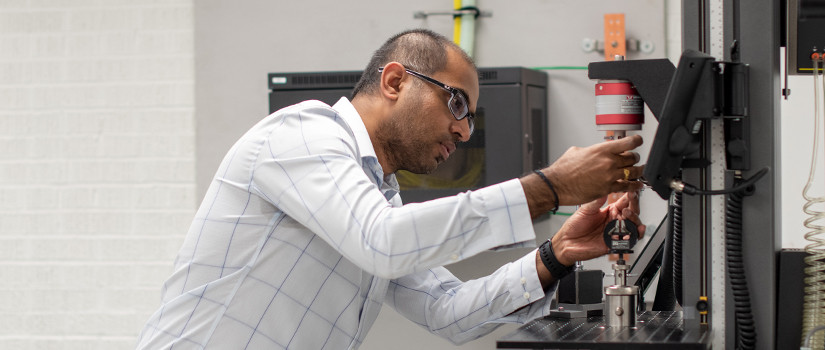Results are expected to produce breakthroughs in the engineering of soldier protection armor materials
By Leigh Thomas | July 20, 2020
Subramani Sockalingam, professor of mechanical engineering in the College of Engineering and Computing, is undergoing two research efforts that will enhance the development of the next generation of military armor materials. One project analyzes polymer fibers and how they respond to impact, and the second involves development of a 3D printing system for creation of new, superior materials. Together, the results could lead to improved performance and survivability of soldier protection body armor.
Sockalingam is studying high performance ballistic fibers, such as Kevlar® and Dyneema®. He explains that they are very small—10-20 micrometers in diameter, smaller than human hair, for example, which is about 80 micrometers in diameter. However, these fibers are very stiff and strong, making them useful for armor applications. Sockalingam’s team is analyzing how the fibers respond to impact loads, when they fail and how they absorb energy.
“Because these materials are being used by soldiers in combat situations, we are looking at two key things for application. We want them to be lightweight for improved mobility and have good ballistic performance for survivability,” Sockalingam said.
Sockalingam is using both computational modeling and experimental techniques to conduct the research through ongoing collaborations with the Army Research Lab (ARL). His students have been conducting experiments at the ARL labs in Maryland during the summer and winter terms, supported by ARL-sponsored internships and fellowships, a significant opportunity for students. Sockalingam explains that one of his students, Frank Thomas, ARL Journeyman Fellowship recipient, defended his master’s thesis by researching these types of fibers and developing experimental techniques to impact them in a controlled manner.
Sockalingam said, “Together with ARL, we are performing experiments to understand how they behave and create new knowledge on how they respond under different load conditions.”
The team is also collaborating with DSM Dyneema, the company that manufactures the fibers used in military armor and the composites made from them. DSM Dyneema is providing the fibers used in the research.
The Army Research Office also recently awarded $160,000 for a state-of-the-art 3D printing system. Sockalingam and Addis Kidane, also a mechanical engineering professor in the college, will study architectued armor materials and develop multiscale additive manufacturing techniques to improve material impact resistance, and as a result, the safety of soldiers in combat. This study involves fiber reinforced composites, functionally graded foam materials and the use of multiscale manufacturing for creating new architectured materials.
Sockalingam said, “While the use of new composites in armored materials has been studied, there is not yet a fabrication technique to achieve control over the composition and structure at multiple length scales. Multiscale additive manufacturing 3D printing provides a promising pathway to overcome this challenge.”
Sockalingam and Kidane hope to develop, through light-based and layer-by-layer 3D printing, an unprecedented capability to design and fabricate these materials with multiscale resolution. The desired result is the design of new materials with superior impact-resistant properties.
“The new equipment acquired through this DURIP grant will enhance the team’s research efforts for the Army by allowing them to fabricate and test materials with elaborate multi-scale architectures that could enable greater ballistic resistance and durability at a reduced weight compared to traditionally structured materials,” said Dr. Denise Ford, program manager, Army Research Office, an element of the U.S. Army Combat Capabilities Development Command’s Army Research Laboratory. “The results of their work could lead to greatly improved soldier and system performance and survivability.”
Sockalingam is an assistant professor of mechanical engineering in the College of Engineering and Computing. His research interests include development of advanced composite materials that are lightweight and stronger through a multiscale experimental and computational approach for aerospace, automotive and defense applications.
Kidane is an associate professor of mechanical engineering in the College of Engineering and Computing.
